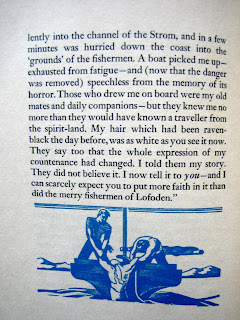

The foliage shifts into its autumn hues as we enter into my favorite season of the year. Having grown up in Salem, MA, however, I’ve always had an ambivalent relationship with October in particular: at no other time is the city more crisp and alive, and yet we also must suffer from the invasion of hundreds of thousands of tourists (many of whom have a dubious relationship, at best, with reality). Perhaps the last remaining tourist attraction in Salem that is both family-friendly and terrifyingly engaging for adults as well is the Salem Theatre Company’s annual Chilling Tales -- a series of live performances of classic ghost stories of the sea, staged by professional actors on board “Friendship”, Salem’s tall-ship replica of a square-rigged East Indiaman trading vessel from the eighteenth century.
This year, to celebrate the 200th anniversary of the birth of Edgar Allan Poe (1809-1849), the Salem Theatre Company will be performing adapted versions of several of Poe’s greatest tales of horror on the high seas. I felt, with the approach of October later this week, it might be interesting if I highlighted a beautifully printed copy of one of these tales in my own collection.

The book is a distinct edition of the Poe short story A Descent into the Maelstrom, printed by the (then three-year old) Powgen Press of New York in March, 1936, and published by William R. Scott. It retailed for $1 according to the price printed inside the front dust jacket flap (about $15.50 in modern dollars); today collectors value it between $20 and $42. Design of the book was done by Powgen’s Ted Gensamer; interspersed throughout the book are nine loosely art-deco style prints (woodcut?) illustrating scenes from the narrative, all made by print artisan Charles E. McCurdy. No doubt to complement the tale’s nautical theme, McCurdy’s artwork is all in a rich but very icy blue.

One of these illustrations appears again on the paper dust jacket (which is quite beat up on my copy); the boards themselves are a deep pebbled blue cloth with the title on a paper slip glued to the spine. The paper is a firm but soft stock with no discernible watermarks; the only foxing appears on the fly-leaves and paste-downs. Each page measures 12.5cm x 17.25cm. Pagination runs [1]-[34] from the start of the story to the end; the half-title, title, and colophon are unpaginated but are integral to their gatherings; there are no signatures. There is conflicting information from dealers online about the format of the book; some claim that it is octavo (“8vo”) but it would appear that the few who refer to it as small duodecimo (“12mo”) are correct according to the American Library Association standards of measurement.

This difference of opinion likely stems from a disagreement about format: in hand-press books the designation refers not to size but to the number of times the full sheet is folded to make up each gathering of leaves (which often results in certain sizes, but this is dependent on the size of the sheet with which the printer begins). Folio is a single fold resulting in two leaves (four pages) per gathering; quarto is four folds for four leaves; octavo is eight; duodecimo is twelve; sixteenmo is sixteen. Because modern books (those printed on machine presses after 1850) are often printed and bound without fidelity to the sheet, and often lack printer’s signatures to mark gatherings, it is almost impossible to discern the number of gatherings, even staring closely down the spine and trying to count the number of leaves in each gathering. Very often -- especially in books printed in the last fifty years -- there are no gatherings at all. To adjust for this, bibliographers of modern books tend to use the old format terminology to refer exclusively to the size of a book. Different people doing this might plausibly see different things, and hence the disagreement about some unsigned modern books’ formats.

Scott's edition of Maelstrom was part of a series of six titles all printed for him by Powgen Press, all in the slim duodecimo format with various colored cloth bindings, and all in 1936. They were issued in board slipcases, which my copy is missing. The other titles in the series were Irving’s The Legend of Sleepy Hollow, Thoreau’s Life Without Principle, Whitman’s Song of Myself, Emerson’s Compensation, and Hawthorne’s Legends of the Province House. Each book was illustrated with art designed by a different, noted print artist of the period (besides McCurdy these include Mary Dana, Joseph A. Low, Barney Moore, and Jean Lamont). The full series, if complete with slipcases and dust jackets, is valued at around $200-$250 (many dealers erroneously list Powgen Press as the publisher; Scott was the publisher, Powgen was the printer).

This collection of craft-printed books is known as the American Renaissance Series and features some of the nineteenth century writers who helped define American literature as a culture distinct from its European forebears. Usually dated from 1850-1855 “American Renaissance” was a critical period, not just for artistic expression by American artists, but also for the renewal of civic pride and nationalism that these writers inspired in the public. My guess is that Scott and Powgen’s decision to issue a series dedicated to recalling this enriching and transformative period in American culture was linked directly to the difficult and depressing context of the mid-1930s.
Certainly the choice of Maelstrom as the Poe story for the series seems to reflect sentiments dominating the national mood during the dark years of financial collapse and European war. Perhaps a modern publisher should reissue the book to speak to our current context as well...that would certainly make for a chilling tale...

No comments:
Post a Comment